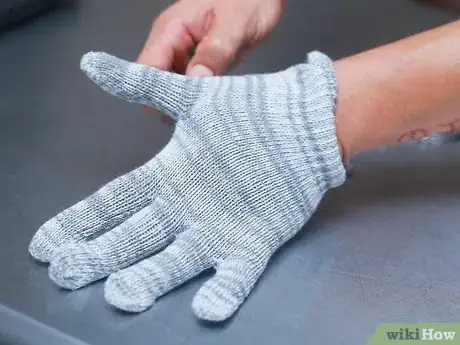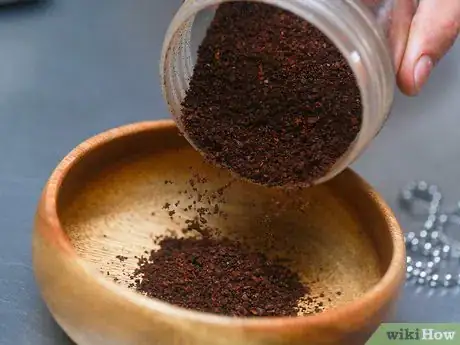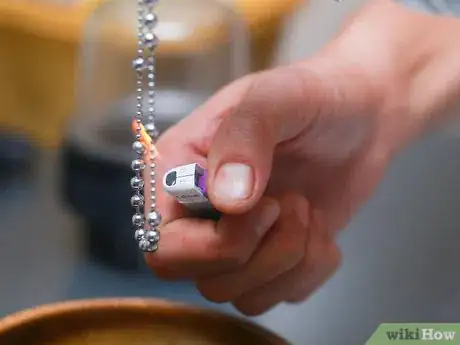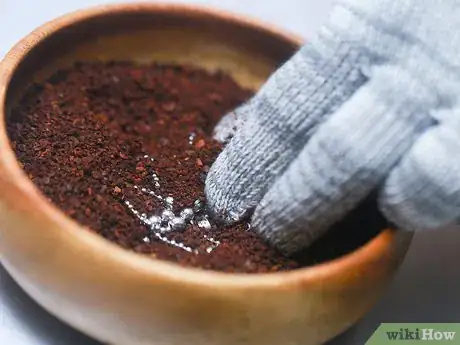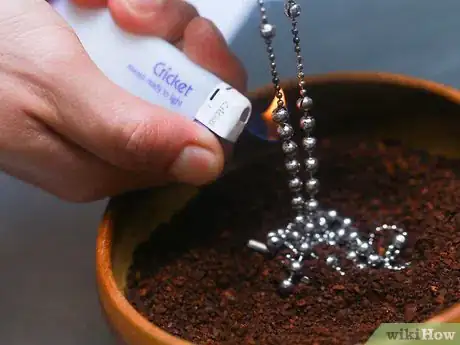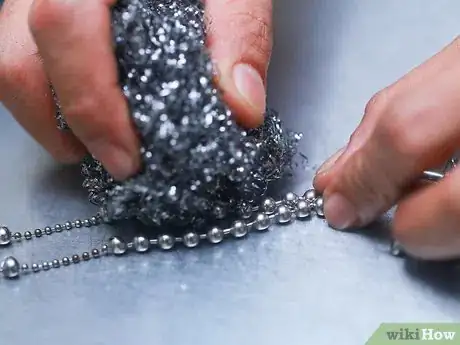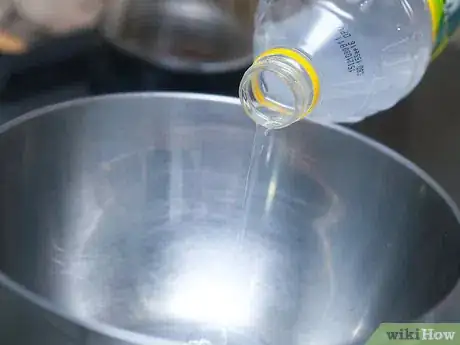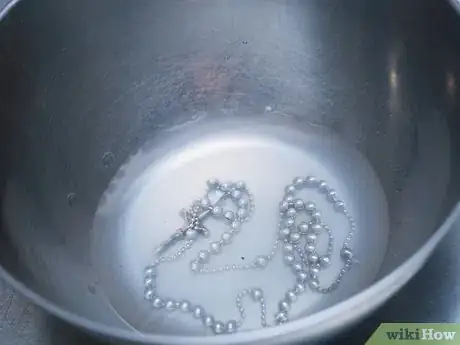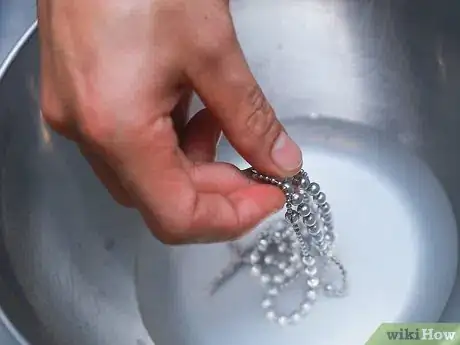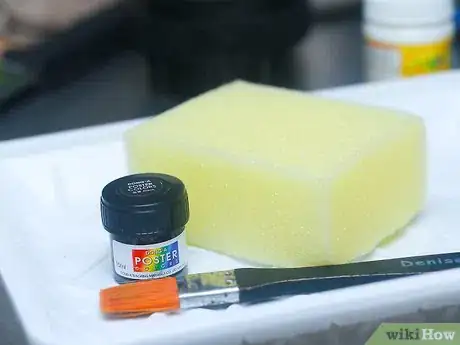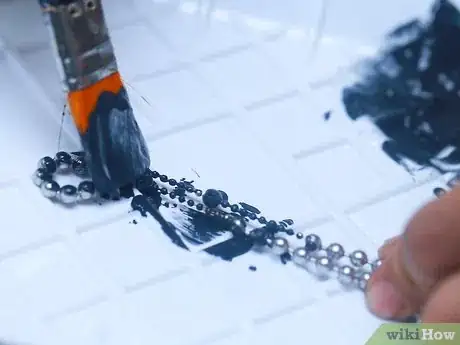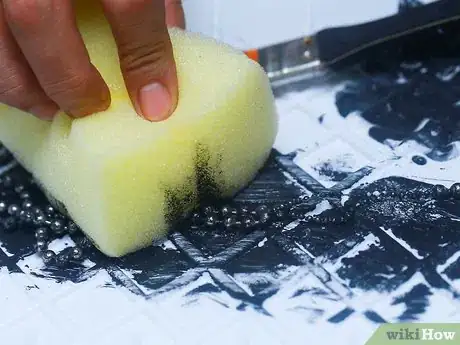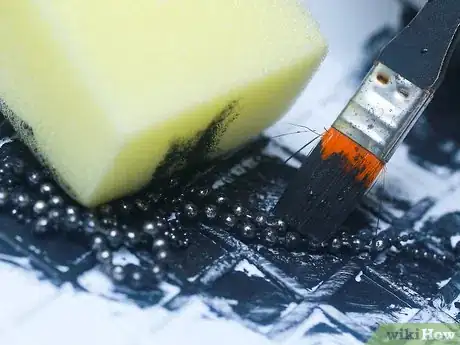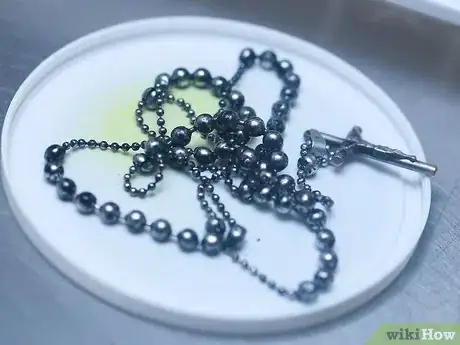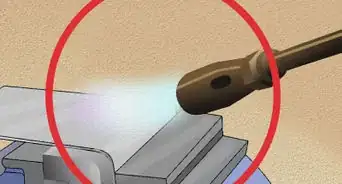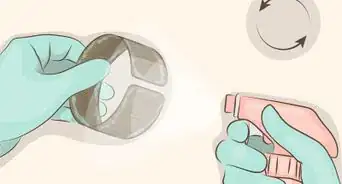wikiHow is a “wiki,” similar to Wikipedia, which means that many of our articles are co-written by multiple authors. To create this article, volunteer authors worked to edit and improve it over time.
This article has been viewed 98,861 times.
Learn more...
There are several ways to give new stainless steel pieces an antiqued appearance. Corroding the metal with vinegar or another abrasive chemical will produce the most natural results. For something faster, you could try heat staining or painting the object, instead.
Steps
Method One: Heated Staining
-
1Wear the appropriate safety gear. At minimum, you should wear safety goggles and heat-resistant, fire-resistant gloves.[1]
- Also note that you will need to handle the stainless steel object with another device, like tongs or a vice. Everything you use should be both fire-resistant and heat-resistant to prevent accidental burns.
-
2Fill a container with warm, moist coffee grounds. You'll need to prepare enough coffee grounds to cover all sides of the stainless steel object you wish to antique.[2]
- If you've recently made a pot of coffee, you can use the spent grounds from that. Otherwise, pour enough warm to hot water over a fresh batch of grounds and give the grounds a few minutes to absorb the moisture
- For small, narrow objects like screws, you can fill a small cup with your prepared grounds. For larger objects, coat the bottom of a shallow tray with the grounds, instead.
Advertisement -
3Heat the steel using a lighter. Hold the metal object with tongs or a vice, then pass the flame of a lighter over the entire length of the object, heating it thoroughly.[3]
- Continue rotating and passing the flame over the stainless steel object until the metal begins to darken in color.
- For larger objects or a more controlled flame, consider using a propane tank with a lighter attachment instead of a handheld lighter.
- The stainless steel will reach temperatures just beneath 500 degrees Fahrenheit (260 degrees Celsius), so you need to work very carefully to prevent accidental burns.
-
4Bury the steel in the coffee grounds. As soon as the steel object darkens, quickly dip the heated portion into the prepared coffee grounds. Hold it in the grounds for 15 to 30 seconds.[4]
- The water in the coffee grounds should quickly cool off the metal. Theoretically, the steel should be safe to touch once you remove it from the grounds, but you should still proceed with caution.
- In addition to cooling off the metal, the coffee should dye the stainless steel, giving it the appearance of antiqued metal.
-
5Repeat as needed. If you want to dye the steel even darker, reheat it and submerge it into the coffee grounds again.
- You should be able repeat the process several times without damaging the metal.
- If you only want to dye one side or area darker, focus the heat on that area and only apply the coffee grounds to that spot.
-
6Polish as desired. When you're satisfied with the results, you can quickly polish the steel object by vigorously rubbing it with a soft cloth.[5]
- Wait until the object is cool enough to touch before polishing it.
- Polishing the piece should buff away coffee granules and some of the dark dye. It should also make the steel a little shinier.
- After you dye and polish the piece to your liking, the project is complete. The results should last indefinitely.
Method Two: Chemical Corrosion
-
1Scuff the steel. Use sandpaper or steel wool to scuff the sides of the stainless steel object.[6]
- Scuffing the steel will create a more age-worn appearance. It also removes some of the protective coating, allowing more of the vinegar to penetrate and work its way through the metal.
- Steel wool pads will usually create deeper scratches, so if you want to create more subtle wear, use sandpaper instead. Choose a medium to heavy grit sandpaper for best results.
-
2Place the piece in a larger container. Place the prepared steel item in a plastic bucket or in another similar container made of non-reactive material.
- All sides you wish to antique should be exposed. If one side is covered or hidden against the side of the container, the vinegar may not work as effectively there.
-
3Cover with vinegar. Pour vinegar into the container, covering all sides of the stainless steel piece.
- You may want to wear safety goggles and safety gloves when handling vinegar. Even though vinegar is a mild acid, it could sting if it splashes into your eyes. Vinegar can also be a mild irritant if you have sensitive skin or if your skin is submerged for prolonged periods.
- Every side touching the vinegar will be affected. Any type of vinegar should work for this project, but white distilled vinegar is recommended since it is fairly cheap and easy to come by.
- If the steel piece starts to float, hold it down by placing stones or dry beans on top of it. Make sure that the vinegar still has access to the piece, however.
-
4Allow it to sit overnight. Keep the steel piece submerged in the vinegar for at least eight hours.
- The piece should look subtly aged and worn as soon as you remove it.
- When you remove the piece, rinse the vinegar away with clean water and dry it with clean towels.
-
5Repeat as desired. If the antiqued appearance isn't as notable as you would prefer, soak the stainless steel for a longer period of time.[7]
- Stainless steel comes in different grades, so this may not be effective on all steel pieces. High-grade stainless steel is more likely to resist corrosion than low-grade stainless steel.
- If the vinegar doesn't produce results, you could try using a more corrosive chemical. Toilet bowl cleaner generally works well. Bleach, denture cleaner, and silver dip may also yield results.
- When using harsher chemicals, always wear safety goggles and rubber gloves.
- Never mix chemicals, either, since doing so can produce dangerous fumes. Thoroughly rinse and dry the piece before attempting to use a different chemical.
- Once you are satisfied with the appearance, the project is complete. These results should be permanent.
Method Three: Acrylic Painting
-
1Prepare your supplies. You'll need metallic acrylic craft paint, an art paintbrush, and a wet sponge.[8]
- Look for a deep gray metallic paint. One labeled as "gunmetal gray" will usually be a good choice.
- Depending on the look you want to create, you may also want to use a copper metallic paint. The copper paint is only optional, though.
- It's also a good idea to have a supply of water ready since you may need to rinse the sponge periodically throughout the process. Consider standing next to a sink. Alternatively, keep a bucket of clean water nearby during the process.
- To prevent things from getting too messy, cover your work area with plastic sheets or newspaper. You may also want to wear an artist's smock or apron to protect your clothes.
-
2Brush on the first coat. Dip the paintbrush in gunmetal gray paint, then apply the paint to the sides of the stainless steel object using even strokes.[9]
- Pour the paint into a disposable paint dish for easy access.
- Apply the paint along the grain of the steel. Cover the entire surface you wish to antique, but do not allow the paint to dry.
-
3Sponge away some of the paint. Dab at the applied paint using the wet sponge. Work your way around the surface, essentially "messing up" the perfect coat of paint you just applied.[10]
- Using a wet sponge instead of a dry sponge should prevent the pattern of the sponge from imprinting itself into the paint.
- You need to remove some of the paint, but you shouldn't wipe all of it away. Much of the paint should still remain after you complete this step.
- As you dab away at the paint, you should notice some spots where the paint smears and others where the paint develops a splattered appearance. Both effects are what you need to retain.
-
4Alternate as needed. Work back and forth between the previous two steps. Apply paint with your paintbrush, then dab some of the paint away with your wet sponge.
- As the sponge gets loaded with paint, you may need to rinse it with clean water. After rinsing the sponge, gently wring it out before returning to the steel piece. You should work with a damp sponge, not one that is dripping wet.
- Continue alternating between painting and sponging until you create a naturally worn appearance.
-
5Let dry. Set the stainless steel piece aside and allow it to dry completely before handling it further.[11]
- Examine the dry piece. Most of the natural metal should show through beneath the coat of paint. Determine whether or not you are satisfied with these results.
-
6Carefully consider additional coats of paint. If desired, you could try adding a coat of copper metallic paint on top of the gunmetal paint. Apply this second coat with the same painting and sponging technique used for the first.[12]
- This second coat is only optional. Understand that it will cover more of the natural metal, and if you don't like the results, you will need to clean off the paint and start from the beginning. It will be impossible to salvage the first layer you applied.
- Avoid adding any coat beyond the second. Adding too many layers may make it more obvious that the piece has been painted instead of naturally aged.
- Once you achieve the desired appearance, the project is complete. Note that the antique effect will last for a long time unless the paint is washed away.
Things You'll Need
Heated Staining
- Stainless steel item
- Safety goggles
- Fire-resistant gloves
- Fire-resistant vice or tongs
- Shallow tray
- Moist coffee grounds
- Propane tank or handheld lighter
- Soft cloth
Chemical Corrosion
- Stainless steel item
- Steel wool or medium/heavy grit sandpaper
- Plastic bucket
- Vinegar
- Small stones or dry beans
- Rubber gloves
- Safety goggles
Acrylic Painting
- Stainless steel item
- Gunmetal gray metallic acrylic paint
- Copper metallic acrylic paint
- Paintbrush
- Wet sponge
- Bowl of water
- Newspaper
- Art smock
- Paper towels
References
- ↑ https://www.finishing.com/584/02.shtml
- ↑ https://www.youtube.com/watch?v=d094vAsrn3g
- ↑ https://www.youtube.com/watch?v=d094vAsrn3g
- ↑ https://www.youtube.com/watch?v=d094vAsrn3g
- ↑ https://www.youtube.com/watch?v=d094vAsrn3g
- ↑ http://www.domestically-speaking.com/2014/07/vinegar-age-stainless-steel-tried-pin.html
- ↑ https://www.bobvila.com/articles/how-to-rust-metal/
- ↑ http://www.snazzylittlethings.com/how-to-age-galvanized-metal/
- ↑ http://www.snazzylittlethings.com/how-to-age-galvanized-metal/
About This Article
You can make your stainless steel look antique with a few different items you probably already have at home. One way is to scuff your stainless steel and soak it in vinegar. First, rub your metal with sandpaper or steel wool to give it a worn look. Then, place it in a bowl and submerge it in vinegar. Leave it to soak overnight or until you get the right look. Another option is to use heated coffee grounds. First, pour some used coffee grounds straight out a coffee pot into a small bowl. Then, hold your object with a pair of tongs and heat the steel with a lighter. As soon as the steel starts to darken, bury it in the coffee grounds and leave it for 30 seconds. Repeat this until you get the antique look you want. For more tips, including how to make your stainless stool look antique with acrylic paint, read on!
